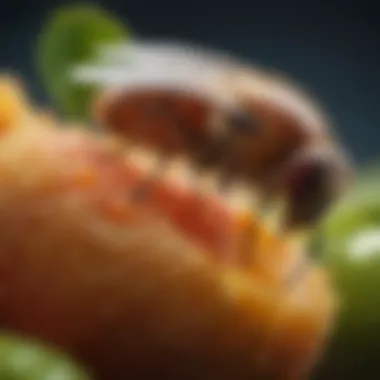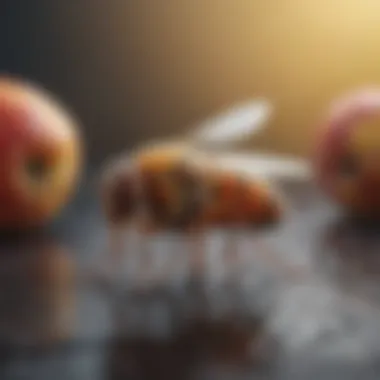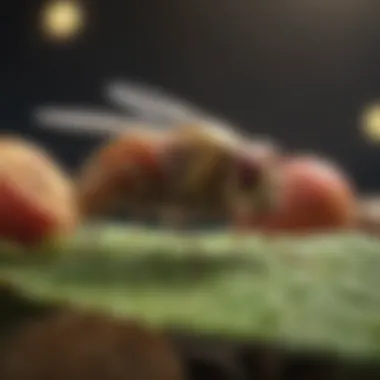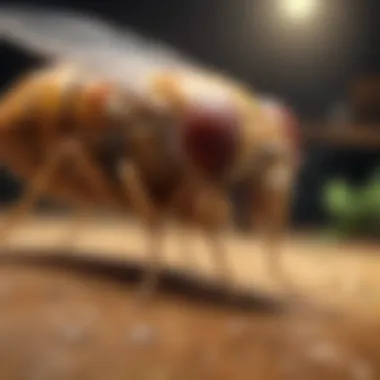Understanding Factors That Attract Fruit Flies: A Comprehensive Guide


Intro
Fruit flies are often seen fluttering around kitchens and grocery stores. Their presence suggests there are attractants nearby. Understanding what draws these small, persistent insects can help in managing their populations. The study focuses on various factors influencing their attraction, especially overripe fruits, sweet flavors, and environmental cues. By gaining insight into fruit fly behavior, individuals and businesses can implement effective strategies for prevention. This knowledge benefits both household environments and commercial establishments.
Animal Overview
Common Names
Fruit flies are commonly known as vinegar flies or pomace flies. The name they are often recognized by is Drosophila melanogaster, which is a model organism widely used in scientific research.
Scientific Classification
The scientific classification of fruit flies places them in the Animalia kingdom, phylum Arthropoda, class Insecta, order Diptera, family Drosophilidae, and genus Drosophila. This classification highlights their position within the diverse group of insects.
Geographic Range
Fruit flies are found worldwide. Their adaptability allows them to thrive in various environments. They are particularly abundant in warmer regions, where conditions suit their life cycle and feeding habits.
Behavior and Social Structure
Social Behavior
Fruit flies display interesting social behaviors. They often congregate around food sources. This gregarious nature aids in finding sustenance quickly.
Communication
Communication among fruit flies primarily occurs through pheromones. These chemical signals facilitate recognition and mating among individuals.
Mating and Reproduction
Mating occurs rapidly in fruit flies. After courtship, females lay eggs on or near suitable food sources. The hatching larvae develop quickly, feeding on the decaying organic matter.
Habitat and Ecosystem
Natural Habitat
Natural habitats of fruit flies include areas with abundant organic matter. These include orchards, gardens, and compost piles. Such environments provide optimal conditions for feeding and breeding.
Food Sources and Diet
Fruit flies are attracted to foods rich in sugars. Overripe fruits, spilled beverages, and sugary substances draw them in. Their diet primarily consists of fungi and decaying fruits, aiding in decomposition processes.
Role in Ecosystem
Fruit flies play a crucial role in ecosystems by assisting in the breakdown of organic materials. This function promotes nutrient cycling, benefiting plant growth.
By understanding fruit fly behavior and attraction, effective control measures can be implemented, ensuring cleaner environments.
Preface to Fruit Flies
Fruit flies, specifically the species Drosophila melanogaster, serve as a model organism in biological research and also pose challenges in food preservation. Understanding fruit flies is important because their attraction to various substances has implications for both households and businesses. Knowing what draws these flies enhances our ability to control their populations effectively.


The significance of studying fruit flies extends to pest management strategies. Awareness of their behaviors and preferences allows for the development of targeted interventions. With the proper knowledge, businesses can safeguard their products, while households can maintain a clean environment.
Overview of Fruit Fly Species
Fruit flies exist in various species, but the most commonly recognized is Drosophila melanogaster. This species is ubiquitous and often found around decaying or fermenting fruit. Other notable species include Drosophila simulans and Drosophila sechellia. Each species has adapted to specific environments, but they share common characteristics in attraction to sugars and volatiles emitted from rotting fruits.
Understanding these species helps in identifying their behavioral patterns. For example, in laboratory settings, Drosophila melanogaster is often used due to its short life cycle and ease of breeding. This research contributes to our knowledge of genetics and behavior, further informing our strategies against pest invasions in food settings.
Life Cycle and Behavior
The life cycle of fruit flies involves four stages: egg, larva, pupa, and adult. The total duration from egg to adult can be as short as eight days under optimal conditions. This rapid reproduction means that a few flies can quickly become a larger population if left unchecked.
Behaviorally, fruit flies are highly opportunistic. They are drawn to the scent of overripe or fermenting fruits due to volatile organic compounds. This attraction increases in warmer temperatures, which accelerates the ripening process, generating even more cues for the flies. In their quest for food, adult fruit flies are known for their agile flight and tendency to swarm in areas with abundant food sources.
Both the life cycle and behavior of fruit flies outline the need for effective control measures in places where food is stored or prepared. Various methods exist for managing infestation, from traps to proper food storage practices. Learning these details can aid individuals and businesses alike in minimizing the impact of these pervasive pests.
Chemical Cues That Attract Fruit Flies
Understanding the chemical cues that attract fruit flies is crucial in controlling their population. These cues come from various organic compounds that signal ripe or decaying fruits, which are ideal feeding and breeding grounds for these pests. Knowing how these chemical cues operate can help in developing effective traps and management strategies, thus minimizing their impact in homes and food establishments.
Volatile Organic Compounds
Key Compounds Identified
Volatile organic compounds (VOCs) play a significant role in attracting fruit flies. These compounds are emitted from ripe or overripe fruits and provide a strong scent that fruit flies can detect from distances. Key VOCs include ethyl acetate, isoamyl acetate, and acetic acid. Each of these compounds is associated with fruit ripening and fermentation. For instance, ethyl acetate has a fruity smell that signals to fruit flies where sustenance is present.
What makes these compounds crucial is their ability to travel through the air, allowing fruit flies to locate potential food sources easily. Ethyl acetate, in particular, stands out because it is common in many ripe fruits like bananas and apples. While beneficial in attracting fruit flies, it may also draw other unwanted insects, necessitating a balanced approach when using these attractants in traps.
Role in Fruit Ripe Detection
The role of these volatile compounds extends beyond mere attraction; they are integral in detecting ripeness in fruits. As fruits mature, they produce ethylene gas, triggering the release of VOCs. This process not only attracts fruit flies but also indicates that the fruit is ready to eat or has begun to rot. This aspect is essential for fruit flies as it leads them to their ideal breeding sites.
In terms of benefits, the capability of these compounds to signal ripeness could be utilized in areas such as agriculture, where farmers can monitor crops better. On the downside, reliance on these natural scents for management could create a cycle where more fruit flies are attracted than kept at bay, further complicating pest control efforts.
Sugars and Alcohols
Effects of Sugar Concentration
Sugar concentration in fruits also plays a vital role in attracting fruit flies. Higher sugar levels are often linked to increased fruit attractiveness, as these insects are drawn to the sweet taste. Sugars like fructose and glucose are more appealing to fruit flies and stimulate feeding behavior.
The significance of sugar concentration goes beyond mere attraction. The sweeter the fruit, the more likely it is to attract fruit flies. This can be particularly important for trapping strategies. By manipulating sugar concentrations in traps, one can increase the likelihood of capturing these pests. However, a high sugar concentration might make traps less effective if not balanced with appropriate attractants.
Fermentation and Alcohol Attraction
Fermentation creates alcohol, which is another factor that draws in fruit flies. As fruits decompose, the natural fermentation process leads to the production of alcoholic compounds that fruit flies find enticing. Alcohol serves as a strong attractant because it is a byproduct of microbial fermentation, which occurs when fruits are damaged or overripe.
The presence of alcohol in decaying fruits makes them much more appealing to fruit flies, signaling a rich food source. This characteristic is particularly noted in beverages and food items that have gone past their prime. Unlike sugars, which are straightforward in their appeal, the attraction to alcohol can create complications. Alcohol can lead to overpopulation in specific areas, thus creating further challenges for pest control in both households and commercial venues.
In summary, both sugars and volatile organic compounds are critical in attracting fruit flies. Understanding these chemical cues provides vital insights into pest behavior and allows for better control measures when dealing with fruit fly infestations.
The Role of Overripe Fruits


Overripe fruits are crucial in understanding the attraction of fruit flies. These fruits emit strong scents and release substances that immediately catch the attention of these pests. When fruits ripen, they undergo chemical changes that make them irresistable to fruit flies. This section analyzes the processes involved during ripening and the specific fruits that draw fruit flies in large numbers.
Ripening Processes
Ethylene Production
Ethylene is a gas and plays an important role during fruit ripening. It is a simple hydrocarbon that regulates various aspects of fruit development. All fruits produce ethylene, and it signals to the plant that it is time to ripen. This characteristic makes ethylene a focal point in the attraction of fruit flies. The concentration of ethylene increases as a fruit ages. Therefore, fruit flies are attracted to ripe fruits more strongly than to unripe ones.
One unique feature of ethylene production is that it can trigger a chain reaction. One ethylene-producing fruit can encourage others nearby to ripen as well. This compound can be seen as both an advantage and a disadvantage. While it can increase fruit ripening and subsequently attract more flies, it can also lead to spoilage if not properly managed. The connection between ethylene and the fruit fly attraction must be highlighted for effective pest control strategies.
Changes in Aroma and Taste
As fruits ripen, their aroma and taste also change significantly. These alterations are consequence of chemical processes that occur alongside ethylene production. The odors emitted by overripe fruits become stronger and more appealing to fruit flies. This enhanced aroma is a significant aspect that contributes to the overall attraction of these pests.
The transformation in taste makes ripe fruits more palatable, which in turn increases the likelihood of fruit flies being drawn to them. A unique characteristic of aroma changes is that they often indicate the fruit's level of ripeness. Therefore, fruit flies utilize these scents to locate food sources. While such changes can be an advantage for enticing these insects, they can also lead to rapid spoilage if ripe fruits are not consumed or managed effectively.
Common Fruits That Attract
Some fruits are particularly attractive to fruit flies due to their chemical composition. Bananas, apples, and peaches are among those commonly found in homes, attracting fruit flies easily. Their sugar content and aroma create an ideal environment for infestation. Understanding which fruits tend to attract fruit flies can assist in better management and prevention techniques in both households and commercial settings.
Common culprits include:
- Bananas
- Apples
- Peaches
- Grapes
By recognizing the role of overripe fruits in the fruit fly lifecycle, homeowners can take important steps for better pest control. When minimizing exposure to these attractants, the effectiveness of management techniques can improve significantly.
Environmental Factors Influencing Attraction
Understanding environmental factors is crucial in analyzing what attracts fruit flies. These factors not only influence the presence of these pests but also provide insight into how we can manage their populations effectively. By recognizing the conditions that favor fruit fly activity, potential areas of infestation can be targeted for remediation.
Temperature Preferences
Temperature plays a significant role in fruit fly behavior and reproduction. Fruit flies generally thrive in warm environments. Ideal temperatures range between 20°C to 30°C (68°F to 86°F). At these temperatures, the metabolic activities in fruit flies increase, enhancing their attraction to potential food sources.
Fluctuations in temperature can also trigger changes in their life cycle stages. For instance, warmer temperatures can accelerate development from egg to adult, which may lead to rapid population growth. Conversely, temperatures below 10°C (50°F) can slow down their activity and reduce the likelihood of sightings, yet fruit flies may remain dormant until conditions improve.
Studies have demonstrated that managing ambient temperature can directly affect the behavior of fruit flies, potentially altering their attraction to different food sources.
Humidity and Moisture Levels
Humidity significantly influences fruit fly attraction. High humidity levels create an inviting environment for fruit flies, as they often prefer moist conditions. It is in these damp settings where they are more likely to find ripe fruits, decaying materials, and other preferred food sources.
The moisture level affects the fermentation process, which generates volatile organic compounds. These compounds are key attractants for fruit flies. Increased moisture often correlates with higher sugar concentrations in overripe fruits. High humidity can also promote mold growth on food items, further enticing fruit flies.
In summary, recognizing temperature preferences and humidity levels is vital for understanding how environmental factors influence the attraction of fruit flies. By leveraging this knowledge, better strategies can be developed for pest control in domestic and commercial settings.
Attractiveness of Common Household Items
Understanding the attractiveness of common household items is crucial for managing fruit flies effectively. These pests often find their way into homes and food establishments, where they can create health risks and nuisance. By identifying which household items draw these insects, we can implement better control strategies. This section highlights the importance of household waste and food items that attract fruit flies, guiding us toward effective prevention measures.
Kitchen Residue and Waste


Kitchen environments are prime locations for attracting fruit flies due to the presence of organic materials. Fruit flies thrive on decaying items and food residues. These include discarded fruits, vegetables, and other perishables that may not be stored properly. Accumulated food scraps in trash bins or near sinks serve as significant attractants.
The biological basis for this attraction lies in the volatile compounds released by deteriorating organic matter. For instance, overripe bananas emit specific odors that fruit flies find enticing. This quality makes ensuring cleanliness in the kitchen essential.
To avoid attracting these pests, consider these practices:
- Store fruits and vegetables in sealed containers.
- Clean counters and surfaces regularly.
- Dispose of waste in tightly sealed trash bins.
- Use compost bins with proper lids.
By maintaining a clean kitchen environment, one can significantly reduce the likelihood of fruit fly infestations.
Beverages and Fermented Products
Beverages, especially those that are sweet or fermented, are also highly attractive to fruit flies. The fermentation process leads to the production of alcohols and acids, which appeal to their olfactory senses. Products such as wine, beer, and fruit juices can act as powerful attractants.
Fruit flies are especially drawn to open containers of these beverages. Their ability to detect the scent of fermentation is advanced, enabling them to find potential food sources. Notably, spills from cocktails or sugary drinks left unattended can also create an ideal environment for these pests.
To mitigate attraction to beverages, implement these approaches:
- Always cover and seal containers of drinks when not in use.
- Clean spills immediately to remove scent trails.
- Store fermented products in the refrigerator when possible.
By paying attention to how beverages are stored and managed within the household, one can further minimize the risk of attracting fruit flies.
Implications for Pest Control
Integrated Pest Management Strategies
Integrated Pest Management (IPM) combines various management approaches to control pest populations effectively. For fruit flies, IPM actions may include:
- Monitoring: Regularly checking for signs of fruit flies in food areas.
- Sanitation: Cleaning surfaces where food and beverages are prepared or consumed. Dispose of food scraps promptly.
- Cultural Control: Adjusting storage methods for overripe fruits to minimize entrapment.
- Chemical Control: When necessary, use insecticides approved for fruit fly management, ensuring they do not contaminate food.
Each strategy is vital for reducing fruit fly populations while protecting human health.
Practical Tips for Prevention
Preventing fruit flies from accessing food sources is key to managing their presence in homes and businesses. Some practical tips include:
- Store Fruits Properly: Keep fruits in a refrigerator to slow down ripening.
- Seal Containers: Use airtight containers for food storage to prevent access.
- Dispose of Waste: Regularly take out the trash, especially organic waste.
- Inspect Produce: Check for overripe or damaged fruit before purchase.
- Close Unused Pathways: Seal any openings where flies can enter, such as small cracks or gaps around windows.
Implementing these tactics can significantly diminish the attraction that fruit flies have to common household items and environments, fostering proactive pest management for everyone involved.
Finale
The conclusion of this article serves a critical role in synthesizing the multitude of factors surrounding fruit fly attraction. Understanding what draws these pests can significantly influence both control measures and prevention strategies.
Through this discussion, readers gain profound insights into the behavior and preferences of fruit flies, illuminating not just the biological mechanisms at play but also the environmental factors contributing to their attraction. The knowledge shared here is especially beneficial for households and commercial food establishments, as it facilitates the establishment of effective pest management practices.
Summary of Key Points
In providing a comprehensive overview, several key points emerge:
- Chemical cues such as volatile organic compounds, sugars, and alcohols are critical attractants for fruit flies.
- Overripe fruits are particularly appealing due to their ripening processes that emit specific aromas and attractants.
- Environmental factors, including temperature and humidity, further enhance the likelihood of fruit fly presence.
- Practical implications of this attraction extend to integrated pest management strategies that can mitigate the nuisance caused by these pests.
These points reinforce the necessity of an informed approach to managing fruit fly populations.
Future Research Directions
Continued research into fruit fly attraction is essential for the advancement of pest control methods.
- Molecular studies on the specific compounds that attract fruit flies could yield breakthroughs in creating targeted traps or repellents.
- Behavioral studies in varying environmental conditions may reveal new insights into how changes in climate impact fruit fly activity and preferences.
- There is also potential in exploring biological control methods, investigating natural predators or parasitoids that could help manage fruit fly populations more sustainably.







